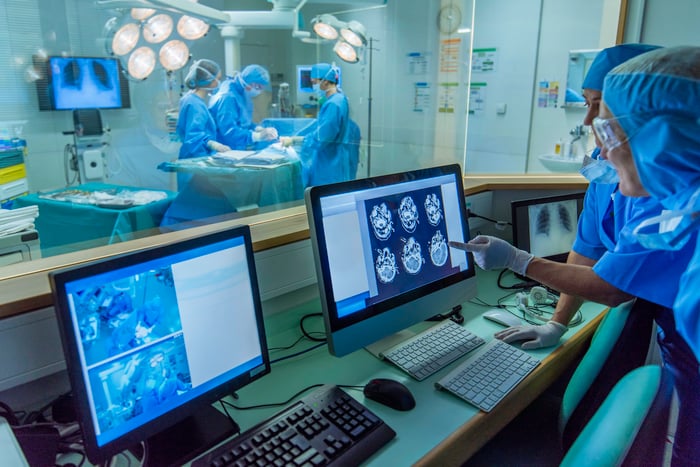The seemingly never-ending struggles of the COVID-19 pandemic have strained many people's lives over the past 18 months. Surgeries and doctor's appointments have been postponed and rescheduled. But the healthcare market is slowly rebounding, and we're starting to see more patients visit their doctors and schedule more elective surgeries.
We're also starting to see delayed technology advancements emerge as the U.S. Food and Drug Administration provides more approvals. One such recent approval, which took place after multiple delays, could have a big impact on how robotic surgery is carried out in the future. NuVasive (NUVA) and its CEO, J. Christopher Barry, believe its milestone launch will lead a digital transformation of spinal surgery.

Image source: Getty Images.
On July 30, NuVasive finally received a long-anticipated FDA approval for its Pulse platform. The subsequent commercial launch has made the product available for sale in targeted global areas, with expansion continuing through the remainder of the year. That approval followed the European Commission's CE marking (that region's version of FDA approval) just one month earlier.
The Pulse system allows multiple technologies to be integrated into one platform to enable improved spine surgery. All members of the surgical team share connectivity and control of the platform, while the system can optimize spinal alignments, automated monitoring, radiation reduction, and more within the operating room. It's touted by the company as a first of its kind because it can be used in all spine procedures and will be able to accommodate future applications such as robotics and smart tools.
Optimistic results
NuVasive was originally hoping to have Pulse ready to roll out sometime last year. But after a delay in February 2020 due to necessary changes exposed by beta testing, and a second delay in August 2020 due to COVID-19-related challenges, FDA clearances were pushed to this summer.
As COVID-19 hampered the timeline for NuVasive, it also took a toll on revenue and earnings in 2020, during which the company saw sales decrease by 10% year over year. Fortunately, the company has rebounded in 2021. The second quarter of 2021 is the fourth quarter in a row in which the company has surpassed consensus estimates on earnings -- in this case, by 39%.
Revenue also topped consensus estimates by 3%, coming in at $294 million for the quarter, an increase of 44% year over year. Q2 revenue topped this year's Q1 numbers by $23 million, for sequential quarterly growth of 8%.
From an earnings-per-share perspective, the second quarter once again showed strength, with EPS of $0.03. That compares favorably with a loss of $0.98 in the same quarter last year, and a loss of $0.15 during the first quarter of this year.
An opportunistic market
The medical device market is expected to grow at a compound annual growth rate (CAGR) of 5.4% through 2026, while the spine market in particular is expected to grow at a CAGR of 20% over that same time period. Now that the Pulse system is FDA-approved, CE-marked, and available for sale, the next challenge will be for NuVasive to prove that its platform can stand tall against its competition.
Medtronic, Zimmer Biomet Holdings, Stryker, and Johnson & Johnson are all formidable competitors in the growing spine market; Medtronic leads the way with an estimated 28% market share in 2021, per SPINEMarketGroup. The good news for NuVasive is that estimates project it to grow by around 11%.
Projections also predict a 0.6% increase in market share, bringing NuVasive's total market share to 13.6% and giving it the largest one-year increase among the group (which also includes smaller competitors Globus Medical and Alphatec Holdings). The compay is in third place for total market share behind Medtronic and Johnson & Johnson.
Wall Street has also been excited about NuVasive's opportunities here. Several investment banks noted during the second delay in August 2020 that it's very important to bring a competitive product to market in this space. Analysts at SVB Leerink stated that "robotics and navigation are clearly gaining surgeon mindshare," while analysts at Needham noted that "the spinal robotics market is significantly underpenetrated."
Priced too high?
NuVasive is operating with momentum in its favor, supported by the recent FDA and CE approvals, as well as positive second-quarter results. It will be very interesting to see how much traction the company can get now that its Pulse system is available.
The company's stock price is sitting right around $60 per share, which is 25% off the high of $80 it reached back in January 2020 and 17% off its 52-week high of $72. Analysts have an average 12-month price target of $73, so the current price is at a 17% discount to that target price. The real pain point that might keep investors from jumping in just yet could be its astronomically high price-to-earnings ratio of 1,671. By comparison, NuVasive's primary competitors, like Medtronic and Stryker, have P/E ratios that currently sit just above 46.
A launch of the Pulse integrated system should help grow revenue, which is already exhibiting strength. In the second quarter, spinal hardware sales totaled $160 million, up 41% year over year thanks in part to its C360 cervical portfolio of products. The Simplify cervical disc alone contributed $2 million to total spinal hardware sales.
It's always good to be aware of recent volatility in the stock price and its current valuation, but the high P/E ratio is likely more a reflection of NuVasive's past and future projected growth than of an inflated stock price. Growing revenue could lead to growing earnings if expenses are kept in check, and it's this anticipated growth that has investors optimistic.

